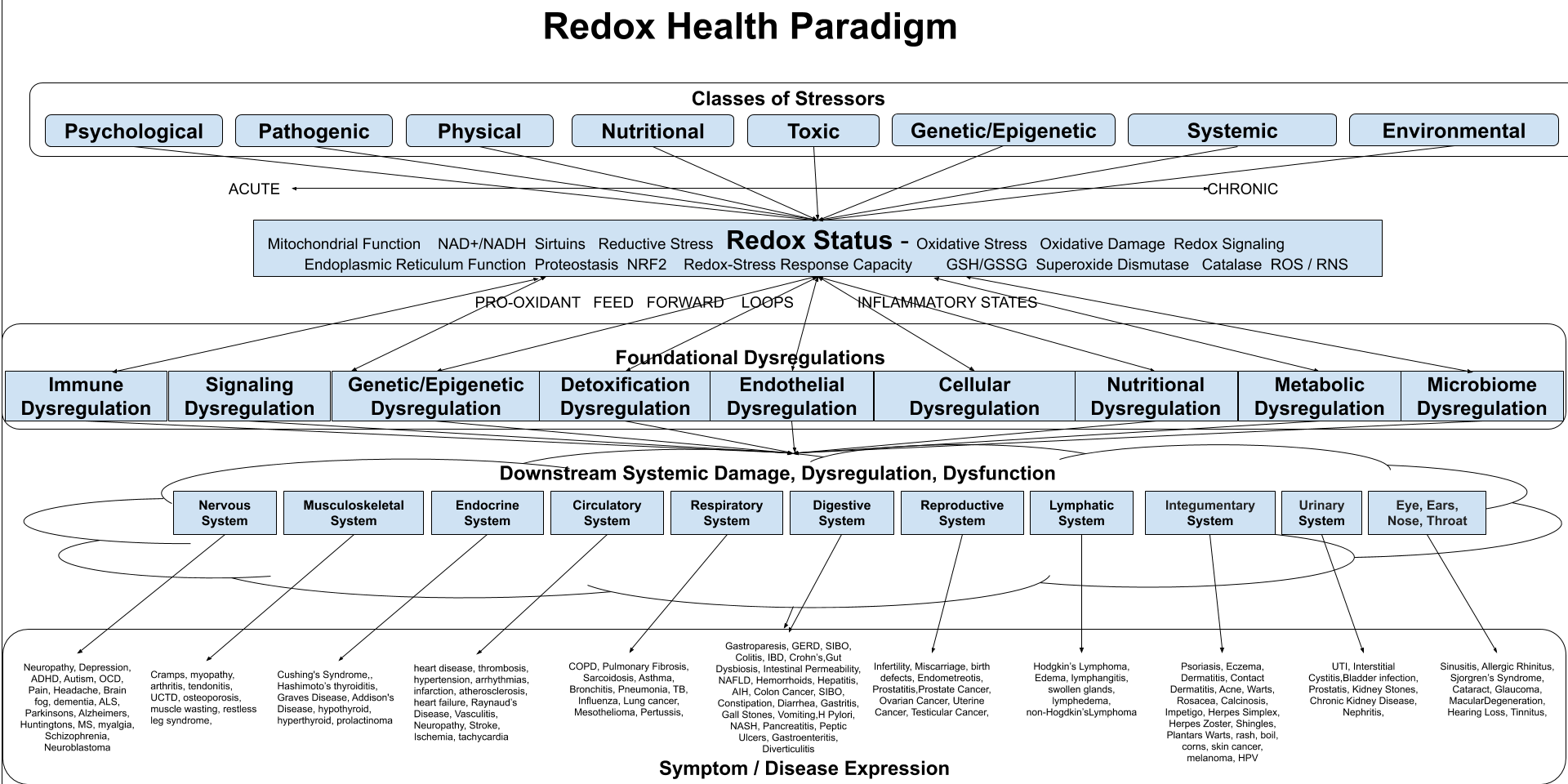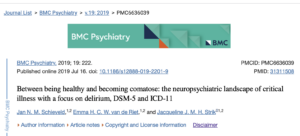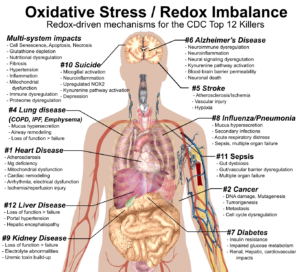When thinking about Redox Imbalance and Redox Health, I’ve found it useful to attempt to frame this material in multiple forms: a thesis statement
“Stress causes disease. Redox imbalance is why”
An 18-minute TED Talk, 95 theses, a short scientific paper, an infographic, the consumer-focused book. Each approach has its own special challenges and yields additional insights. For example, here’s the 400-word synopsis, presented in three levels:
Level 1: There eight categories of stress
- Psychological (What we typically think of as stress)
- Pathogenic (fungal, bacterial, viral infections, parasites)
- Toxic (poisons, pharmaceuticals, xenobiotics, heavy metals, biological waste products)
- Nutritional (processed carbohydrates, sugar, high-heat cooking, allergens, anti-nutrients, overeating, malnourishment)
- Physical (Injury, damage, imbalance, physical stress, under-use, inactivity)
- Environmental (Light, sound, radiation, electromagnetic fields, heat, cold, barometric pressure changes)
- Genetic/Epigenetic (genetic variants that affect redox status, signaling, systemic regulation, immune response, pathological gene expression)
- Systemic (damage and dysregulation of your bodily systems)
Level 2: These stressors cause a universal threat response in your cells: over-production of reactive oxygen and/or nitrogen species (which are toxic but also important foundational signaling molecules that activate cellular defenses and protective systems such as the immune system, the sympathetic nervous system, and the endocrine system.
A healthy redox system (short for reduction/oxidation) promotes stress resilience and can protect the body from most day-to-day threats and actually benefits from low-levels of oxidative stress, a process known as hormesis. But when stress is too great or prolonged the redox system can get overwhelmed and dysregulated (low antioxidant capacity/low glutathione ratio and/or low NAD+/NADH ratio).
Level 3: Having low-antioxidant capacity makes you vulnerable to self-sustaining oxidative stress states, inflammatory cascades and feedforward loops, which are manifested in 8 foundational dysregulations, which are:
- Nutritional dysregulation
- Immune dysregulation
- Signaling dysregulation
- Microbiome dysregulation
- Metabolic dysregulation
- Genetic/Epigenetic dysregulation
- Detoxification dysregulation (liver, kidney, gallbladder, spleen, lymphatic system, etc)
- Endothelial dysregulation (circulatory system, gut barrier, blood-brain barrier, gut-vascular barrier)
Each of these areas is vulnerable to self-sustaining oxidative stress/inflammatory loops, which cause disease progression and symptoms in multiple bodily systems.
Treating Redox Imbalance. The Redox Health Paradigm provides a framework for therapeutic interventions that are designed to stop oxidative damage and dysregulated signaling so that the body’s own healing capacity can restore your health.
Interventions steps:
Level 1: Identify and mitigate unhealthy stressors
Level 2: Bolster and maintain stress resilience with regular exercise, 7-8 hours of high-quality sleep nightly, a nutrient-dense diet, effective stress management and intelligent supplementation as needed to restore and maintain stress resilience, energy production and healthy immune function.
Level 3: Identify and disrupt self-sustaining oxidative stress/inflammatory loops with antioxidants, amino acids, probiotics and antimicrobials; Pharmaceuticals and surgery are a last resort.





